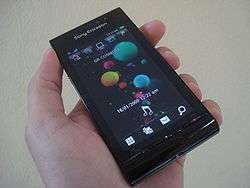Sony Ericsson Satio
|
Sony Ericsson Satio | |
| Codename | Kokoro |
|---|---|
| Manufacturer | Sony Ericsson |
| Compatible networks |
GSM GPRS/EDGE 850/900/1800/1900, UMTS HSDPA 900/2100 (Satio), |
| Availability by country | 7 October 2009 (UK), Late 2009 (USA) |
| Form factor | Touchscreen |
| Dimensions | 112 x 55 x 13 mm |
| Weight | 126 grams |
| Operating system | Symbian OS 9.4 running S60 5th edition |
| Memory | 256 MB RAM and 128 MB ROM (Internal storage) |
| Removable storage | MicroSD up to 32 GB, 8 GB included |
| Battery | Li-Po 1000 mAh |
| Data inputs | Touchscreen and 3 buttons below screen |
| Display | TFT touchscreen, 16M colours 3.5 in (89 mm), 360 x 640 pixels |
| Rear camera | 12.1 MP, 4000 x 3000 pixels, auto-focus, xenon flash, video LED flash |
| Connectivity | Wi-Fi (802.11 b/g, DLNA), A-GPS, Bluetooth (v2.0 with A2DP) |
The Sony Ericsson Satio (U1) is a smartphone, announced by Sony Ericsson at the Mobile World Congress in Barcelona, Spain on 15 February 2009 as the Idou (pronounced "I do").[1] It was released on 7 October 2009 in the UK in 3 colour schemes: Black, Silver and Bordeaux (Red).[2]
The focus of the phone is the high quality playback of music and video, as well as photography. The camera is located on the back of the phone, behind a slider and features a xenon flash. On the side of the phone, there is a shutter button, and a button which allows you to switch between still and video modes. Next to this is a rocker switch for zooming in and out. Also on this side is a button for playback of photos or video. The other side of the phone has a sliding lock button and a covered slot for a MicroSD card.
The front of the phone is dominated by a 3.5-inch (89 mm), 16:9 ratio 360x640 TFT resistive touchscreen.[3] There is also a front-facing camera for video calling. At the bottom of the touchscreen are three small buttons: green (left), white (centre), and red (right).
In terms of software, Satio uses the Symbian OS 9.4 operating system, which is created collaboratively under the stewardship of the Symbian Foundation.[4] It uses the PlayNow service, Sony Ericsson's mobile content platform, and is part of the company's new Entertainment Unlimited service.[5] In terms of connectivity, it is Wi-Fi-enabled and has a GPS chip for navigation and location-based services. It also supports full Flash for video playback.
The phone was withdrawn from sale in November 2009 by two major British retailers due to complaints from customers.[6] However, the problem was found only in UK editions of the phone and was probably caused by carrier-specific customizations. The following software update released by Sony Ericsson provided a fix and the phone was back for sale at those two retailers.[7]
Sony Ericsson Satio and then Sony Ericsson Vivaz are the latest additions of Sony Ericsson to the Symbian Family phones. After that, all Sony Ericsson smartphones run Android.
Features
- 16:9, 3.5 inch widescreen
- 12.1-megapixel camera, intuitive touch focus, Xenon flash and face and smile detection
- Symbian S60 5th Edition Operating System
- Touch navigation
Dimensions
- 112 x 55 x 13 mm
Display
- nHD TFT resistive touchscreen[8]
- 16 million colours
- 360 x 640 pixels
- 3.5"
Memory
- Internal storage: 73 MB
- RAM: 256 MB
- Micro SD memory card support
Connectivity
- aGPS
- Bluetooth technology
- Modem
- PC Synchronization
- USB support
- USB mass storage
- Wi-Fi 802.11 b/g, DLNA
- Google Maps
- PictBridge
- TV Out
- Data Transfer
- Sync
Camera
- 12.1 MP (can use 2 MP, 5 MP, 9 MP, 10 MP and 12 MP modes)
- Digital zoom - up to 16x
- 4000 x 3000 pixels
- Auto-focus
- Video recording (640x480 @ 30 frame/s, WVGA 864x480 @ 24 frame/s via software update)
- Video light
- Xenon Flash
- Video blogging
- Geo-Tagging
- BestPic
- Face detection
- Image stabilizer
- Photo fix
- Picture blogging
- Red-eye reduction
- Smile detection
Internet
- Web browser - WebKit
- Web feeds
- Opera Mobile 10.1 For the Symbian OS
- SkyFire
- Skype
Entertainment
123
- 3D games
- Java
- Media
- Radio - FM radio
- Video Clip
- Video streaming
- YouTube
Messaging
- Exchange ActiveSync
- Instant messaging
- Picture messaging (MMS)
- Predictive text input
- Sound recorder
- Text messaging (SMS)
Communication
- Polyphonic ringtones
- Speakerphone
- Vibrating Alert
- Video calling
Design
- Auto rotate
- Navigation key
- Picture wallpaper
Organiser
- Alarm clock
- Calculator
- Calendar
- Document editors
- Document readers
- Flight mode
- Handwriting recognition
- Notes
- Phone book
- Touchscreen
CPU
- Texas Instruments OMAP3430 Cortex-A8 @ 600 MHz
- 3D Accelerator PowerVR SGX530
See also
- OMAP
- Samsung Pixon12
- Nokia N8
- Symbian S60
- List of Symbian devices
- Comparison of smartphones
- Comparison of Symbian devices
References
- ↑ Infosync World: Sony Ericsson Satio, Aino and Yari Unveiled
- ↑ Pocket Picks - We all say “I Do” to Sony Ericsson’s beautiful Idou
- ↑ http://www.geeks.co.uk/8508-the-sony-ericsson-satio
- ↑ All About Symbian - MWC: Sony Ericsson announce the Idou
- ↑ Eddy, Nathan (2009-02-16). "MWC: Sony Ericsson Unveils Idou, Entertainment Unlimited Strategy". eWeek. Retrieved 2012-04-20.
- ↑ Neate, Rupert (2009-11-23). "Carphone Warehouse and Phones4U suspend sales of Sony Ericsson's Satio after customer complaints". UK: The Telegraph. Retrieved 2012-04-20.
- ↑ Wiles, Andy (2009-12-10). "Sony Ericsson solves Satio, Aino glitches with software update". IBTimes UK. Retrieved 2012-04-20.
- ↑ http://www.geeks.co.uk/8508-the-sony-ericsson-satio
